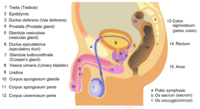
Photo from wikipedia
© BMJ Publishing Group Limited 2022. No commercial reuse. See rights and permissions. Published by BMJ. DESCRIPTION A 25yearold patient was referred by his physician to our radiology department for… Click to show full abstract
© BMJ Publishing Group Limited 2022. No commercial reuse. See rights and permissions. Published by BMJ. DESCRIPTION A 25yearold patient was referred by his physician to our radiology department for a scrotal ultrasound (US) because of discomfort and occasional dull pain in the left hemiscrotum in the last year. He had no previous scrotal or inguinal surgery and this was his first scrotal imaging. The patient reported a history of left renal agenesis diagnosed with ultrasound and a subsequent upper abdominal MRI when he was 12. The scrotal US scan showed a thickened and inhomogeneous, hypoechoic left epididymis (figure 1A) with normal vascularisation at Doppler imaging (figure 1B), findings consistent with ejaculatory duct obstruction. Both testicles were normal for size, echotexture and vascularisation; no significant hydrocele or varicocele was found; scrotal walls were normal. The additional use of a convex probe showed a left periprostatic cystlike structure. Given these findings and the anamnestic report of renal agenesis, a pelvic MRI was performed, confirming a gross ipsilateral cystic dilatation of the left seminal vesicle (figure 2). Unilateral renal agenesis, ipsilateral seminal vesicle cysts and ejaculatory duct obstruction represent a triad of mesonephric (Wolffian) duct anomalies consistent with Zinner syndrome. This syndrome can remain asymptomatic or become symptomatic usually between the second and fourth decade of life. Symptoms are often nonspecific, mostly related to difficulties in voiding and ejaculation and perineal or scrotal pain; it can also cause infertility in up to 45% of patients. It is considered the male counterpart of MayerRokitanskyKusterHauser female syndrome. Imaging allows the correct diagnosis, which is sometimes incidental, ensuring proper differentiation with other pelvic cystic masses. Seminal vesicle cysts should be differentiated from other cysts such as prostatic utricle cyst (an area of focal dilatation that occurs within the prostatic utricle), mullerian duct cyst (a cyst that arises from remnants of the Müllerian duct) and ejaculatory duct cyst (usually intraprostatic, due to obstruction of the ejaculatory duct which in turn can either be congenital or secondary). Ultrasound is usually the first diagnostic step because it does not involve radiation exposure, it is inexpensive and noninvasive. Transabdominal US is preferred because of less discomfort for the patient, whereas transrectal US provides excellent visualisation of seminal vesicle cysts and can be a good choice for the followup. MRI on the other hand allows a multiplanar study, facilitates the differential diagnosis with other pelvic cystic malformation, and can be useful for surgical planning. Typical findings are paramedian and periprostatic cysts, hypointense on T1weighted and hyperintense on T2weighted images, without contrast enhancement after gadolinium intravenous administration. If the cysts have proteinaceous or haemorrhagic components, the T1weighted signal increases. When cysts are asymptomatic or paucisymptomatic or are less than 5 cm in diameter, conservative medical therapy is indicated with followup through firstlevel examinations such as transrectal ultrasound. Surgical treatment is indicated in the case of symptomatic patients, when the cysts are more than Figure 1 Ultrasound sagittal plane imaging of the body of the left epididymis, in (A) inhomogeneously hypoechoic and thickened. In (B) power Doppler imaging shows normal vascularisation, thus virtually excluding the possibility of inflammation. A small amount of anechoic fluid consistent with hydrocele surrounds the left epididymis and testicle.
Journal Title: BMJ Case Reports
Year Published: 2022
Link to full text (if available)
Share on Social Media: Sign Up to like & get
recommendations!